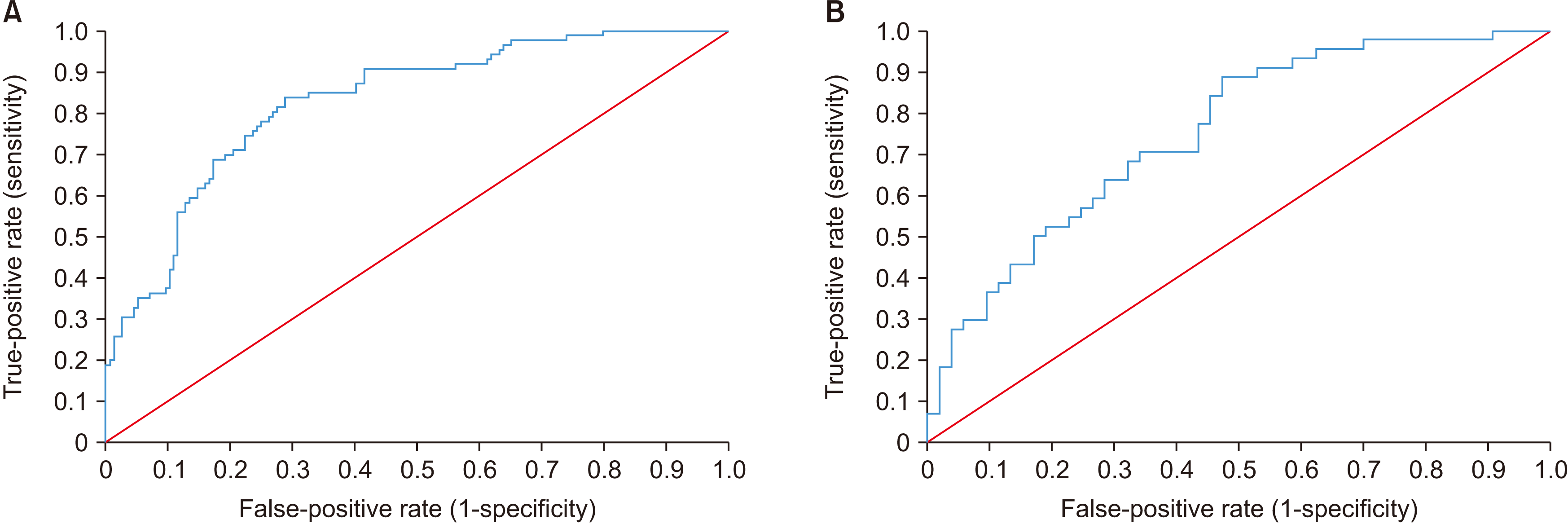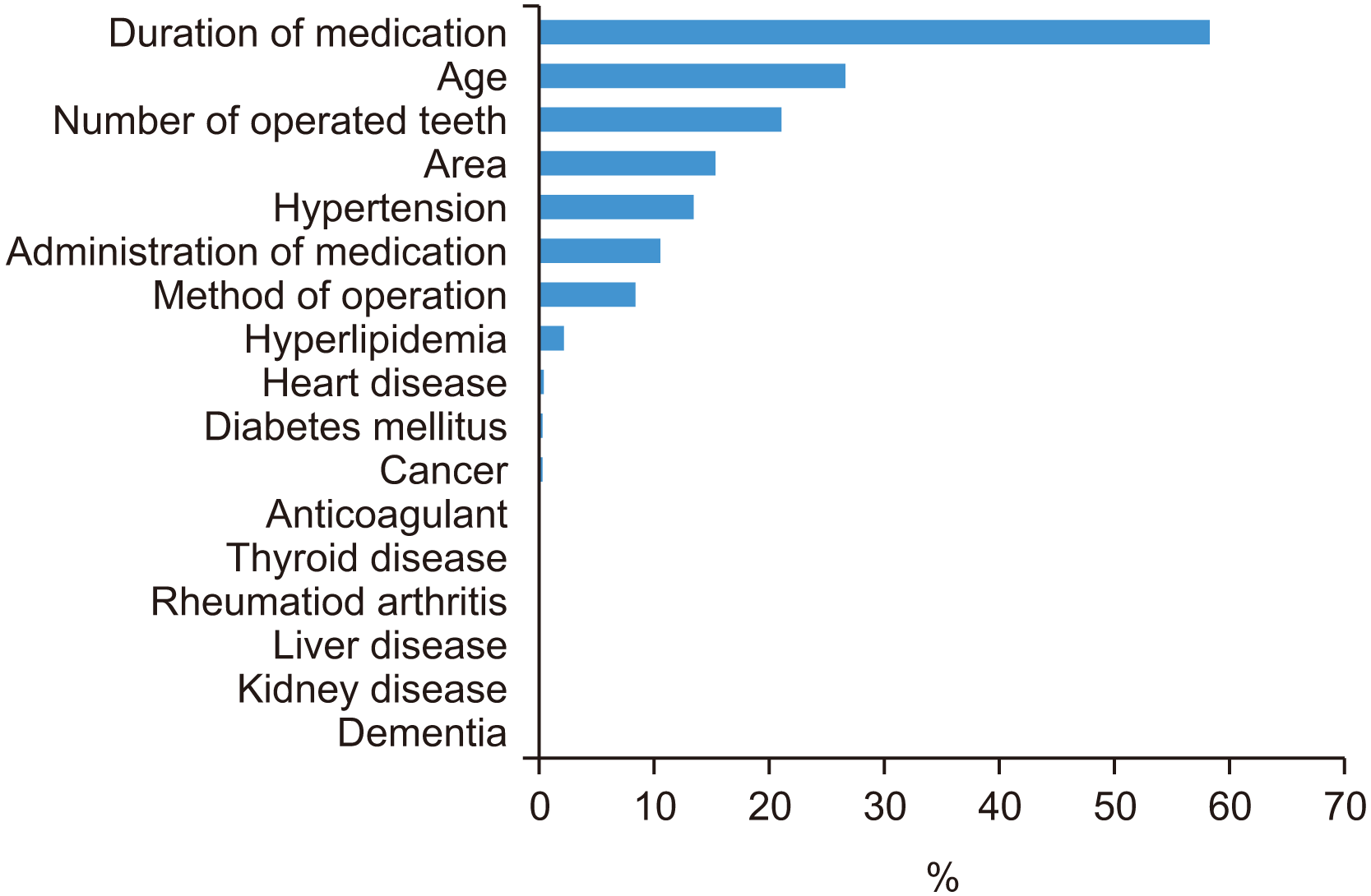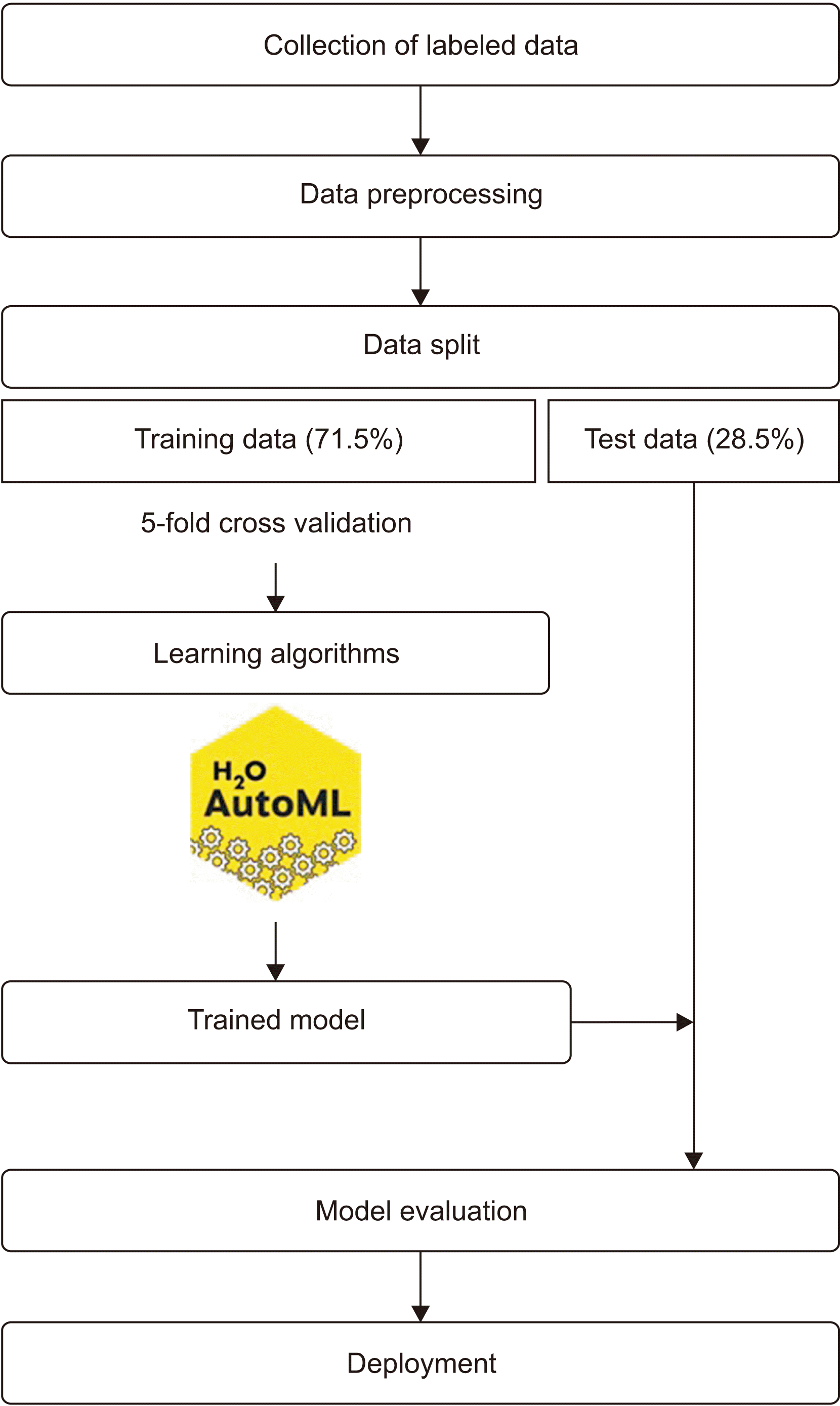I. Introduction
Recently, the medical field has begun developing machine learning (ML) models that can aid doctors in their decision-making regarding diagnosis, prognosis, and management of multifactorial diseases
1-3. The dentistry field is using ML to improve patient care
1,3-5. For example, a deep-learning-based convolutional neural network algorithm was used to diagnose dental caries in periapical radiographs
4, and neural network ML considering several cephalometric variables was used to diagnose the need for extractions in the field of orthodontics
5. Additionally, various studies using artificial intelligence (AI) have been published in the fields of oncology and periodontics
3.
As a subtype of AI, ML extrapolates results based on data and algorithms. The algorithms are trained using data with previously determined input-output relationships to infer output data with high predictability for new input data
6,7. As the demand for ML increases, automated ML programs that can be used effectively by non-experts are available for free or a nominal fee (e.g., DataRobot, H2O-AutoML, H2O-Driverless AI product, Darwin, Google Cloud AutoML, TPOT)
8.
Medication-related osteonecrosis of the jaw (MRONJ) is a multifactorial disease. Although medication is one of the main risk factors, local, demographic, and systemic factors also affect its occurrence
9. Medications that can influence MRONJ occurrence include antiresorptive therapies such as bisphosphonates (BPs), denosumab (DMB), and romosozumab, which are administered orally or parenterally to manage osteoporosis, cancer-related bone metastases, and metabolic bone diseases. MRONJ risk in patients with osteoporosis ranges from 0.02% to 0.3%, which is not higher than that in patients taking drugs for other diseases
9. However, MRONJ can reduce quality of life, and it is even life-threatening in some cases
10; hence, early diagnosis and treatment are critical. It is important to not only accurately diagnose MRONJ in a timely manner, but also to predict potential occurrence and provide appropriate follow-up during the perioperative surgical period.
The aim of this study was to develop and validate ML models that can predict MRONJ occurrence with information obtained from a questionnaire. We used an automated ML program, H2O-AutoML, to develop models for patients with osteoporosis who had undergone tooth extraction or implantation surgery.
Go to :

III. Results
Of the 29 models developed for predicting MRONJ, 20, including 14 GBM, 4 stacked ensemble models, 1 DRF model, and 1 XGBoost model, showed very good diagnostic accuracy with an AUC ≥0.8. The GBM model had the highest AUC value. The training and test dataset metrics for the model are presented in
Tables 3 and
4, respectively. This model comprised 42 trees with a maximum depth of 6 and showed an AUC of 0.8283 on the training dataset.(
Fig. 2. A) At the maximum F1 threshold, the sensitivity and specificity were 83.7% and 71.3%, respectively. For the validation dataset, the model showed a stable AUC of 0.7526.(
Fig. 2. B) At the maximum F1 threshold, the sensitivity and specificity were 88.6% and 52.8%, respectively.
 | Fig. 2Area under the receiver operating characteristic curves (AUCs) of best performed gradient boosting machine model. A. Training dataset (AUC=0.8283). B. Test dataset (AUC=0.7526). 
|
Table 3
|
MRONJ |
Predicted |
|
|
Negative |
Positive |
Total |
|
Actual |
|
|
|
|
Negative |
112 |
45 |
157 |
|
Positive |
14 |
72 |
86 |
|
Total |
126 |
117 |
243 |

Table 4
|
MRONJ |
Predicted |
|
|
Negative |
Positive |
Total |
|
Actual |
|
|
|
|
Negative |
28 |
25 |
53 |
|
Positive |
5 |
39 |
44 |
|
Total |
33 |
64 |
97 |

Variable importance analysis, shown in
Fig. 3, revealed that the duration of medication was the most important variable, followed by age, number of operated teeth, operation area, hypertension, and administration of medication.
 | Fig. 3
|
Go to :

IV. Discussion
Korea has a rapidly aging population; thus, a large proportion of the population has potential for osteoporosis
16. BPs are frequently prescribed for female patients diagnosed with osteoporosis after menopause because they are non-invasive and easy to take orally. However, with age, the need for tooth extraction and implantation increases. Unfortunately, life-threatening MRONJ could occur after a seemingly simple dental treatment, and it cannot be easily predicted due to limited available information. Although biomarkers such as the C-terminal telopeptide of type-I collagen obtained through blood tests have been used in MRONJ clinical decision-making, their use remains controversial. While a drug holiday can be considered to reduce MRONJ risk in patients undergoing tooth extraction or implant surgery, it is not always feasible due to potential side effects such as skeletal-related events, fragility fractures, increased rebound bone resorption, or in emergency surgery situations. Recommendations for the duration of a drug holiday also remain controversial
9. Recently, parathyroid hormone therapy, which stimulates new bone formation by osteoblasts, has been highlighted as an alternative drug. However, its use is limited to 24-month regimens due to potential side effects, and the subcutaneous daily injections required could be challenging for elderly patients
17.
This study demonstrates the effectiveness of ML models for predicting MRONJ occurrence using only questionnaire-based information in patients with osteoporosis who have undergone tooth extractions or implant surgery. We objectively and consistently collected information from patients using BPs who visited our hospital in 2017 using the same questionnaire, which allowed for consistent and objective data collection. One advantage of our models is that they were developed based only on the questionnaire at the first visit, without the need for imaging or laboratory tests. These features enable surgeons to make clinical decisions and educate patients with more accurate information.
Most models in this study showed good diagnostic accuracy, with an AUC ≥0.8. For the validation dataset, the model showed an AUC of 0.7526, which is slightly lower but still a good predictive value. Additionally, sensitivity increased from 83.7% to 88.6%, and specificity decreased from 71.3% to 52.8%. With reference to our model, sensitivity can be seen as a more important indicator than specificity in that our model is intended to predict the possibility of MRONJ occurrence for educating patients and for follow-up.
We also compared variable importance.(
Fig. 3) The most important variable was duration of medication use, followed by age. In this study, the mean ages of the control and MRONJ groups were 73.1 and 77.2 years, respectively, and the mean durations of medication use were 3.4 and 5.8 years. Both variables were significantly higher in the MRONJ group than in the control group. Many studies have also found significant increases in incidence rates, from 0.04% to 0.21%, in patients with osteoporosis who had been using BPs for more than four years
9,18,19. As osteoporosis in women generally occurs after menopause, age and duration of medication are closely related.
The second most significant variable was the number of teeth that underwent operation. Some studies have found that the MRONJ incidence rate was significantly higher in cases of multiple-tooth extractions than in single-tooth extractions
20. However, our analysis showed that the average number of teeth extracted in the MRONJ group was lower than that in the control group, which contradicts previously reported results. In response to these results, other studies have reported that tooth extraction does not act as a local factor alone, but it is associated with the presence or absence of inflammatory dental disease
9,19,20. Therefore, it is necessary to also consider the presence or absence of periodontal disease.
Several studies have reported on the surgical area associated with MRONJ, showing that MRONJ prevalence is two to three times higher in the mandible than in the maxilla
9,19,20. The results of our study are consistent with previous studies, in that we found 27% and 69% prevalence in the maxilla and mandible, respectively.
The most important variable in patient medical history was hypertension. Despite several studies showing that hypertension, diabetes, and anemia significantly enhance the risk of MRONJ incidence
9,21,22, in this study, hypertension was the most significant variable. Although the risk of overfitting in this algorithm cannot be completely ruled out because the variable distribution is not uniform, the association between MRONJ and hypertension has not been well studied, and further research is needed.
This study has several limitations. First, we collected the data from a single institution, and to include a large number of MRONJ cases (n=130, 38.2%) compared with the low incidence, we excluded drug holiday or steroid therapy from variables, which are also correlated with increased MRONJ risk
9. Nevertheless, none of the variables showed a uniform distribution between the MRONJ and control groups. This may have caused overfitting or underfitting of the ML models. Second, the model was designed using only medical records based on patient questionnaires. Nonetheless, it is meaningful in that it created a model with a high AUC value. However, the accuracy of the model can be improved by considering variables from other records, including objective laboratory, genetics, or imaging data
3. Finally, because the ML algorithm infers results by considering numerous factors at once, it is impossible to produce a single exact value for each variable.
A predictive model may help clinicians explain the possibility of MRONJ in greater depth to patients and help them actively cope with future complications before tooth extraction or implantation. Moreover, in the future, AI-based programs may support high-quality patient care and facilitate advanced decision tools. In future research, we anticipate developing a computerized system that can collect, computerize, and share big data from multiple institutions, including radiograph and laboratory data, in addition to medical history data.
Go to :






 PDF
PDF Citation
Citation Print
Print





 XML Download
XML Download